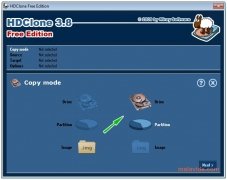

You really can’t set any options on the next screen in the free version, so just click “Next” again. HD Clone will automatically create a folder named “HDClone Images”, where the backup image will be stored, so you can’t place it in another folder yourself – it’s best to just leave it there. Obviously, you’ll need a hard drive or partition larger in size than the drive you want to backup – let’s say that you want to create the HDD backup on an external hard drive that is connected to your computer – just select it in the list, then give the backup image a name (it can’t have any spaces, so use dashes instead) and click “Next”. Now you need to select where the backup image will be created. In this example, I selected the first drive, which is my system drive. First, you’ll need to select the source drive – this is the drive that you want to backup. HD Clone will scan for your system and present you with a list of detected hard drives (and flash drives).

Now, click on “Store Entire Disk”, then click on the “Next” button in the lower right corner:

You’ll see a notification of the limitations of the free version – just click “Close”. Now that you have it unpacked, open the folder and run “hdclone.exe”, then press “Start HD Clone”:
#Hdclone mac download#
I recommend the Universal Package, just download it and unpack it somewhere (desirably on a separate HDD/flash drive, but it can be on the drive you want to backup, as well). To begin, download HD Clone from the official site, – you can get the Setup version or the Universal Package – the only difference is that the first installs on your computer and places shortcuts in the Start Menu and Desktop, while the second can be unpacked on any hard drive or flash drive (or burnt onto a CD!) and executed on any computer.
#Hdclone mac full version#
The full version has some advanced features like compression, selective partition backup/restoration and creating virtual disks for use in virtual machines – all great features, but the free version is enough for our needs. The basic version is free and lets you backup and restore full hard disk images with ease, although the speed is limited. The Windows version of HD Clone is very easy to use.
#Hdclone mac how to#
Thanks to HD Clone, however, it’s extremely easy to create (and restore, of course) a full hard drive backup from within Windows – even if it’s the drive the OS is running from! Below you’ll find a step by step tutorial on how to do just that.Ĭreating a full hard drive backup image using HD Clone
#Hdclone mac software#
It used to be that creating such a backup was difficult and required special software that would only run from within DOS, so you had to create bootable disks or USB drives and mess around with an unfriendly interface. Maybe there is something that you forgot to backup, or maybe you just want an easy way to restore your system drive if your main hard drive fails – having a full backup solves that problem. HD CloneĪn introduction to HD Clone and full disk backupsĬreating full disk backups, as opposed to just copying the most important files into a folder on another hard drive, has the advantage of saving all of your data. Keeping your data and files safe is a priority nowadays, and the most sure fire way to do that is by keeping full hard drive backups, that’s why you need a good tool you can rely on e.g. In this tutorial, you’ll find out how to create full hard drive backups using HD Clone from within Windows.


 0 kommentar(er)
0 kommentar(er)
